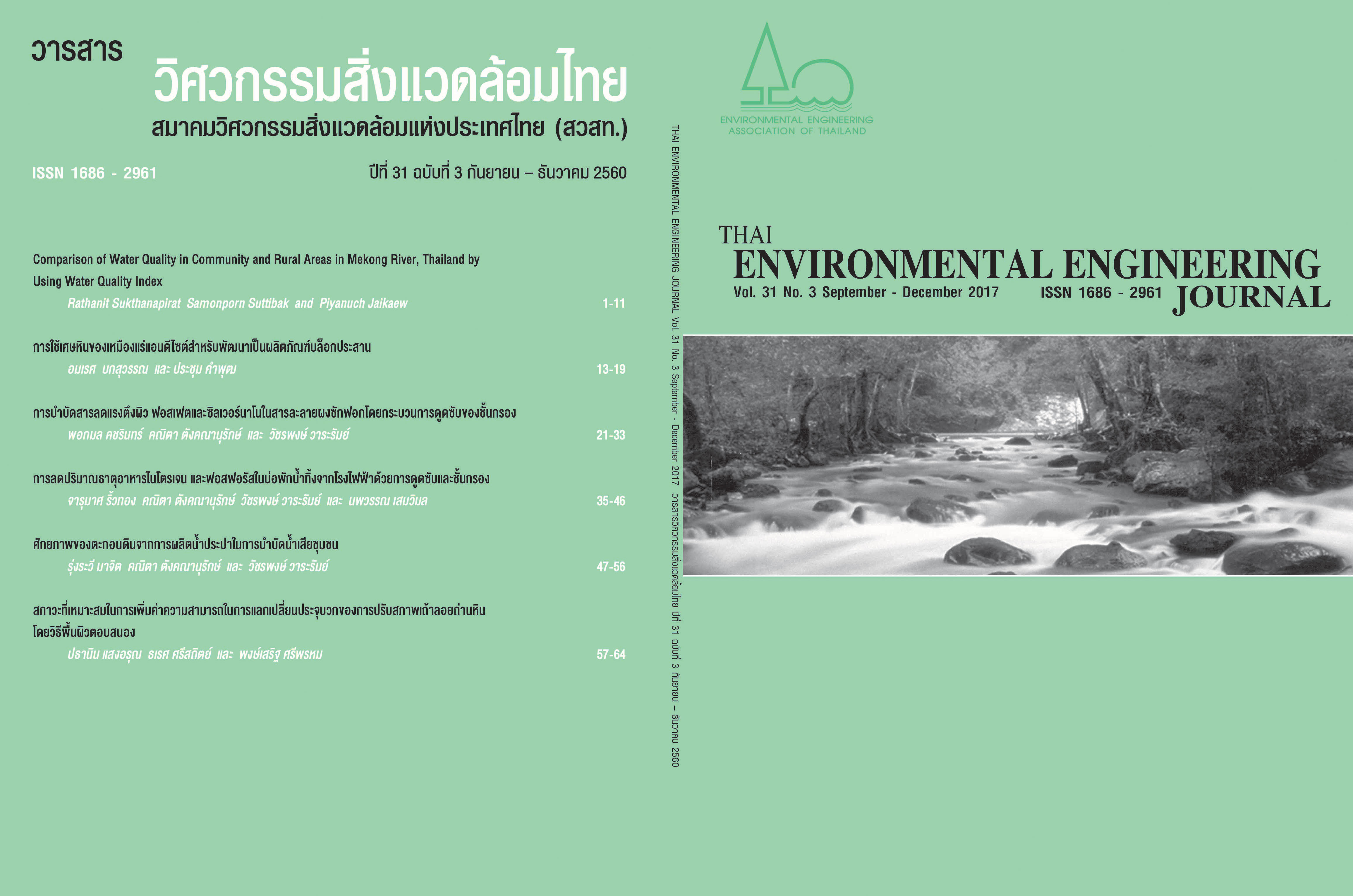Treatment of Surfactant Phosphate and Nano – Silver in Laundry Detergent Solution by Adsorption Process of Filter Layer
Main Article Content
Abstract
The effective prevention and mitigation of water pollution and ecological degradation from eutrophication was the minimization of organic substance and N and P nutrients to the standard set out before discharging into bodies of water. Particularly, discharging the laundry wastewater directly into public water resource had widely effects on aquatic environment. The objectives of this research was to treat surfactant, phosphate and nano-silver in laundry wastewater by using adsorbents such as lignite fly ash (LFA), waterworks sludge (WWS) and chitosan (CS) from shrimp shell. The batch experiments were performed in laundry detergent solution (LDS) (35 g/60 L of water) to determine the removal efficiency of COD, phosphate and nano-silver. The results revealed that COD, phosphate and nano-silver were removed by LFA (91.30, 70.25 and 82.61% respectively), WWS (56.52, 66.67 and 82.61% respectively) and CS (65.22, 68.82 and 91.30% respectively). For column treatment, which was designed in 5 treatments: 1st column consist of 5 filter layers (stone, gravel, mixed LFA with coarse sand 1:40, mixed WWS with coarse sand 1:40 and chitosan 1g) 2nd column consist of 4 filter layers (stone, mixed WWS with coarse sand 1:40, gravel and chitosan 1g)
3rd column consist of 4 filter layers (stone, mixed LFA with coarse sand 1:40, gravel and chitosan 1g) 4th column consist of 3 filter layers (stone, spherical ceramic fly ash and chitosan 1g) and 5th column consist of 3 filter layers (stone, spherical ceramic WWS and chitosan 1g). In each treatment time of 5 columns with using 250 mL of LDS, the experimental results showed that the highest removal efficiency of COD (>67%), phosphate (>76%) and nano-silver (>50%) could be achieved from the 4th column by effluent was agree with the water quality of the standard. Moreover, the 4th column had a long duration time than the other column. Furthermore, the 5th column was the 2nd of a good removal efficiency but had a short time to use than the 4th column. Therefore, this research could be applied to set a expanded scale filter tank for available support a large amount of laundry wastewater.
Article Details
References
[2] Jutarat Kuandee. 2013. The Utilization of Chitosan from Shrimp Shell and Commercial Chitosan to Remove Dyes in Textile Wastewater from Doi Tung Development Project. (in Thai)
[3] APHA, AWWA. and WEF. 2005. Standard Methods for the Examination of Water and Wastewater. 21st edition. American Public Health Association, Washington, DC.
[4] United States Environmental Protection Agency. 2017. Drinking Water Contaminants – Standards and Regulations. Available Source: https://www.epa.gov/dwstandardsregulations#List, July 20, 2017.
[5] Roongtip Ruilao. 2001. Analysis of Surfactant and Phosphate Content in Home Laundering Wastewater. Master of Home Economics. Major Field Home Economics. Department of Home Economics. (in Thai)
[6] Maitree Doungsawas. 1983. Effect of detergents on Fisheries. E-THAI FISHERIES GAZETTE. ‘receive from’ https://www4.fisheries.go.th/local/index. php/main/view_activities/1282/38961# (in Thai)
[7] Narut Sahanavin and Jirawan Torit. 2012. Eutrophication. Journal of Faculty of Physical Education. Vol.15 (Supplement). Srinakharinwirot University. (in Thai)
[8] Worawut Matthayan, Sopa Visitsak and Khedari, Joseph. 2011. Improvement of compressive strength for adobe block by using lime and palm oil ash. Proceedings of 49th Kasetsart University Annual Conference: Architecture and Engineering. (in Thai)
[9] Duangkamol Suriyachat, Phasan Wichit Amornphan and Wanthana Ruangsueng. 2004. Application of sediment Soil from tap water. 1st edition. Bureau of Basic Industries Department of Industry and Mining, Bangkok. (in Thai)
[10] Phawadee Methakanon, Asira Fuengfuchat and Kongkiat Kongsuwan. 2000. Introduction to Chitin-Chitosan. MTEC. Journal of Materials Technology. 19: 69-75. (in Thai)
[11] Chiou, M.S. and H.Y. Li. 2003. Adsorption behavior of reactive dye in aqueous solution on chemical cross-linked chitosan beads. Chemosphere. 1095-1105.
[12] Feng, C.W., L.T. Ru and S.J. Ruey. 2000. Comparative Adsorption of Metal and Dye on Flake and Bead Types of Chitosan Prepared from Fishery Wastes. Hazardous Materials. 73: 63-75.
[13] Tungkananuruk N, Tungkananuruk K. Principle of Chemical Water Quality Analysis, Kasetsart University Press, Bangkok. 2007.
[14] Pollution Control Department. Waste Water Manual. 2017 ‘receive from’ http://www.pcd.go.th/public/Publications/print_water.cfm?task=WasteWaterManual (in Thai)


